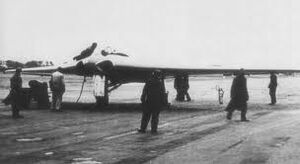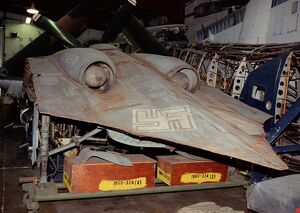
The Horten H.IX was an aircraft built at the end of the Second World War. It was designed by Walter and Reimer Horten. It was the first flying wing aircraft with jet engines. Even if tailless flying wing aircraft were rather unstable, the Horten outperformed the Me 262, the first jet powered fighter, in close dogfight, what making the design the most advanced World War II fighter.
History[]
The first Horten aircraft specifically intended for combat, design work for the Horten H.IX (later 8-229) began in 1942. As the two BMW 109-003A-1 engines could not be installed through the spars, due to their larger than anticipated diameter, the first aircraft was test flown as a glider, with non retractable nose wheel, during the summer of 1944.[1]
Construction[]

The sole surviving Ho 229 at the Smithsonian's Garber Restoration Facility.
The airframe consisted of a centre section of welded steel tube and wooden outer panels, all covered with plywood. The wing had a leading edge sweep of 32 degrees, rounded tips and sweptback trailing edges which curved aft near the centre section to form a pointed tail fairing. On powered aircraft, this had the plywood covering protected by steel sheets, with a small air space between them and the wing surface. [1]
Specification[]
Applies to the Gotha Go 229, derived from the Horten H.IX

Measuring 24 ft 6 1/8in (7.47 m) long, with a wingspan of 55 ft 0 3/8 in (16.78 m), The 229 had a loaded weight of 18,743 lb (8,500 kg), maximum speed of 621 mph (1,000 km/h) at 20,000 ft (6,100 m) and a landing speed of 81 mph (130 km/h).[2]
References[]
- ↑ 1.0 1.1 Kay, Antony L and J R Smith. German Aircraft of the Second World War. Putnam Aeronautical Books. Revised 2002 edition. ISBN 0 85177 920 4 Page 177
- ↑ Kay, Antony L and J R Smith. Page 178